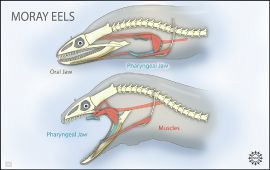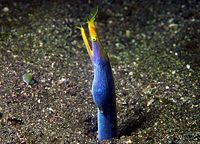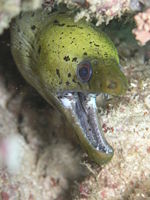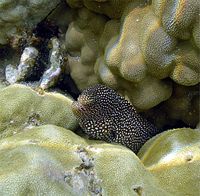Moray eel
| Moray eel | ||||||||||||
|---|---|---|---|---|---|---|---|---|---|---|---|---|
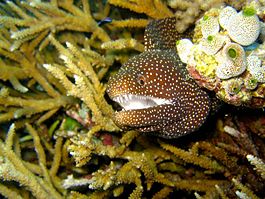 | ||||||||||||
| Scientific classification | ||||||||||||
| ||||||||||||
|
See text. |
Moray eels are large cosmopolitan eels of the family Muraenidae. There are approximately 200 species in 15 genera. The typical length of a moray is 1.5 m (5 ft), with the largest being the slender giant moray, Strophidon sathete, at up to 4 m (13 ft).
Overview
Eel is the common name for any of the various members of the fish order Anguilliformes, which are characterized by an elongated, snake-like body, the absence of pelvic fins, and typically without scales or with the scales embedded in the skin.
Eels, members of Anguilliformes, lack pelvic fins and the associated skeletal structures. The pectoral fins (in those species that have them) are at least midlateral in position or higher and lack the posttemporal bone, which connects the shoulder girdle to the skull. The caudal and anal fins are long, usually connecting with the tail (caudal) fin. The caudal fin lacks rays or may be absent. The body is very elongated.
The number of rays of the gill webbing ranges from six to 51, though sometimes they are absent altogether. The scales are usually absent, but if present are cycloid and embedded in the skin.
The flat and transparent larva of the eel is called a leptocephalus. A young eel is called an elver. Morphologically, the leptocephali larva of anguilliforms often differ considerably from the adults, to the extent that it is difficult to determine which leptocephali are the young of which adult (Nelson 1994).
Nelson (1994) recognizes three suborders, 15 families, 141 genera, and about 738 species in Anguilliformes. The following classification by FishBase recognizes 15 families but in 4 suborders. Among differences are the recognition by Nelson of suborders Anguilloidei (with three families), Muraenoidei (with three families), and Congroidei (with 9 families), while FishBase recognizes suborders Anguilloidei (with six families), Congroidei (with six families), Nemichthyoidei (with two families), and Synaphobranchoidei (with one family). In Nelson (1994), suborders Anguilloidei and Muraenoidei include the same families that FishBase includes in Anguilloidei.
Suborder Anguilloidei
- Anguillidae (freshwater eels)
- Chlopsidae (false morays)
- Heterenchelyidae
- Moringuidae (spaghetti eels)
- Muraenidae (moray eels)
- Myrocongridae
Anatomy
The dorsal fin of the moray extends from just behind the head, along the back and joins seamlessly with the caudal and anal fins. Most species lack pectoral and pelvic fins, adding to their snake-like appearance. Their eyes are rather small; morays rely on their highly developed sense of smell, lying in wait to ambush prey.
The body of the moray is patterned, camouflage also being present inside the mouth. Their jaws are wide, with a snout that protrudes forward. They possess large teeth, designed to tear flesh as opposed to holding or chewing.
Moray eels' heads are too narrow to create the negative pressure that most fish use to swallow prey. Moray eels have a second set of jaws in their throat called pharyngeal jaws, which also possess teeth. When feeding, morays launch these jaws into the oral cavity, where they grasp struggling prey and transport it into the throat and down to the rest of the digestive system. Moray eels are the only known type of animal that uses pharyngeal jaws to actively capture and restrain prey.[1][2][3] Morays are capable of inflicting serious wounds to humans.
Morays secrete a protective mucus over their smooth scaleless skin which contains a toxin in some species. Morays have much thicker skin and high densities of goblet cells in the epidermis that allows mucus to be produced at a higher rate than in other eel species. This allows sand granules to adhere to the sides of their burrows in sand-dwelling morays[4], thus making the walls of the burrow more permanent due to the glycosylation of mucins in mucus. Their small circular gills, located on the flanks far posterior to the mouth, require the moray to maintain a gape in order to facilitate respiration.
Morays are carnivorous and feed primarily on other fish, cephalopods, mollusks, and crustaceans. Groupers, other morays, and barracudas are among their few predators. There is a commercial fishery for several species, but some have been known to cause ciguatera fish poisoning. Morays hide in crevices in the reefs, and wait until their prey is close enough for capture. They then lunge out and clamp the prey in their strong jaws.
Behavior
Cooperative hunting
In the December 2006 issue of the journal, Public Library of Science Biology, a team of biologists announced the discovery of interspecies cooperative hunting involving morays. The biologists, who were engaged in a study of Red Sea cleaner fish (fish that enter the mouths of other fish to rid them of parasites), discovered that a species of reef-associated grouper, the roving coral grouper (Plectropomus pessuliferus), often recruited morays to aid them while hunting for food. This is the first discovery of cooperation between fish in general. [5] [6]
Reputation
Morays have sometimes been described as vicious or ill-tempered. In fact, morays are shy and secretive, and they only attack humans in self-defense. They also accidentally bite human fingers when being fed, because they cannot see or hear very well, although they have an acute sense of smell. Morays hide from humans and would rather flee than fight. Morays, however, do inflict a nasty bite, because, although not poisonous, their backward-pointing teeth are covered with bacteria which may infect the wound. Another danger that morays present is when they are eaten. If the eels have eaten algae, or fish that have eaten algae, they will cause ciguatera fish poisoning if eaten. Morays rest in crevices during the day and are nocturnal predators, and although they may ensnare small fish and crustaceans that pass near them during the day, they mostly come out at night. [7]
Distribution
Moray eels are cosmopolitan, found in tropical and temperate seas.
Ecology
Habitat
Morays frequent tropical, warm waters, and subtropical coral reefs to depths of 150 m, where they spend most of their time concealed inside crevices and alcoves.
Classification
Genera
- Anarchias
- Channomuraena
- Cirrimaxilla
- Echidna
- Enchelycore
- Enchelynassa
- Gymnomuraena
- Gymnothorax
- Monopenchelys
- Muraena
- Pseudechidna
- Rhinomuraena
- Scuticaria
ReferencesISBN links support NWE through referral fees
- ↑ Mehtal, Rita S. and Peter C. Wainwright (2007-09-06). Raptorial jaws in the throat help moray eels swallow large prey. Nature(journal) 449: 79-82.
- ↑ Hopkin, Michael (2007-09-05). Eels imitate alien: Fearsome fish have protruding jaws in their throats to grab prey.. News. Nature.com. Retrieved 2007-09-06.
- ↑ National Science Foundation (Sep. 5, 2007)
- ↑ Skin morphology and cytology in marine eels adapte...[Anat Rec. 1996] - PubMed Result
- ↑ An Amazing First: Two Species Cooperate to Hunt | LiveScience
- ↑ PLoS Biology - Interspecific Communicative and Coordinated Hunting between Groupers and Giant Moray Eels in the Red Sea
- ↑ PLoS Biology - Interspecific Communicative and Coordinated Hunting between Groupers and Giant Moray Eels in the Red Sea.
- Froese, R., and D. Pauly (eds.). 2006. Anguilliformes. FishBase. Retrieved September 29, 2007.
- Herbst, S. T. 2001. The New Food Lover's Companion: Comprehensive Definitions of Nearly 6,000 Food, Drink, and Culinary Terms. Barron's Cooking Guide. Hauppauge, NY: Barron's Educational Series. ISBN 0764112589.
- Integrated Taxonomic Information System (ITIS). 2004a. Muraenidae ITIS Taxonomic Serial No.: 161160. Retrieved June 1, 2008.
- Integrated Taxonomic Information System (ITIS). 2004b. Muraeninae ITIS Taxonomic Serial No.: 635303. Retrieved June 1, 2008.
- Integrated Taxonomic Information System (ITIS). 2004c. Uropterygiinae ITIS Taxonomic Serial No.: 635302. Retrieved June 1, 2008.
- Nelson, J. S. 1994. Fishes of the World, 3rd ed. New York: John Wiley & Sons. ISBN 0471547131.
External links
Credits
New World Encyclopedia writers and editors rewrote and completed the Wikipedia article in accordance with New World Encyclopedia standards. This article abides by terms of the Creative Commons CC-by-sa 3.0 License (CC-by-sa), which may be used and disseminated with proper attribution. Credit is due under the terms of this license that can reference both the New World Encyclopedia contributors and the selfless volunteer contributors of the Wikimedia Foundation. To cite this article click here for a list of acceptable citing formats.The history of earlier contributions by wikipedians is accessible to researchers here:
The history of this article since it was imported to New World Encyclopedia:
Note: Some restrictions may apply to use of individual images which are separately licensed.
